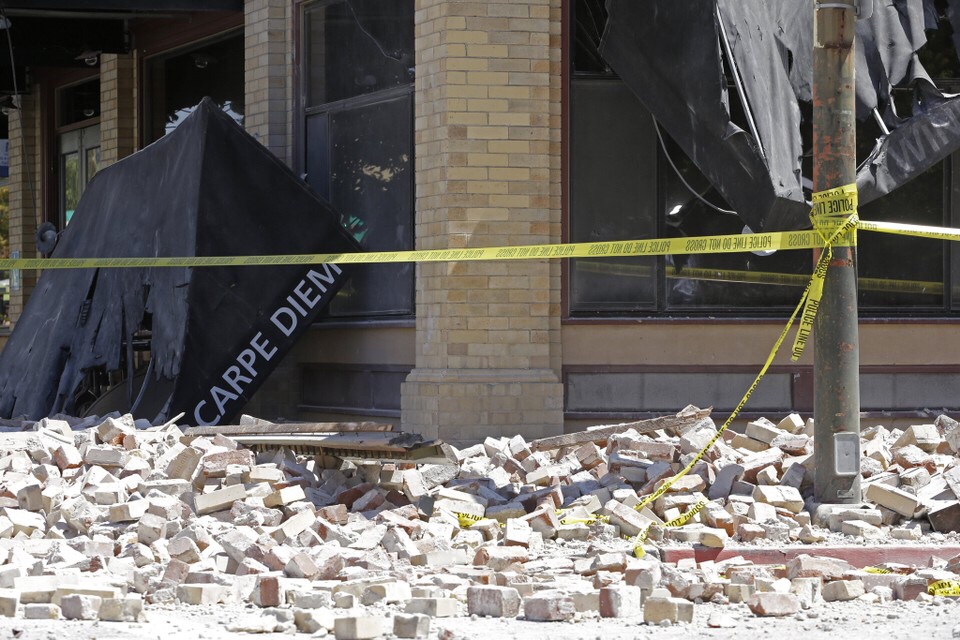 NYC earthquake risk: Could Staten Island be heavily impacted?
NYC earthquake risk: Could Staten Island be heavily impacted?By Ann Marie Barron
Updated May 16, 4:31 AM; Posted May 16, 4:00 AM
Rubble litters Main Street after an earthquake struck Sunday, Aug. 24, 2014, in Napa, Calif. A report by the U.S. Geological Survey outlines the differences between the effect of an earthquake in the West vs. one in the East. (AP Photo/Ben Margot)
STATEN ISLAND, N.Y. - While scientists say it's impossible to predict when or if an earthquake will occur in New York City, they say that smaller structures -- like Staten Island's bounty of single-family homes -- will suffer more than skyscrapers if it does happen.
"Earthquakes in the East tend to cause higher-frequency shaking -- faster back-and-forth motion -- compared to similar events in the West,'' according to a report by the U.S. Geological Survey (USGS), published on its website recently "Shorter structures are more susceptible to damage during fast shaking, whereas taller structures are more susceptible during slow shaking.''
DIFFERENCES IN INTENSITY
The report, "East vs West Coast Earthquakes,'' explains how USGS scientists are researching factors that influence regional differences in the intensity and effects of earthquakes, and notes that earthquakes in the East are often felt at more than twice the distance of earthquakes in the West.
Predicting when they will occur is more difficult, said Thomas Pratt, a research geophysicist and the central and Eastern U.S. coordinator for the USGS Earthquake Hazards Program in Reston, Va.
"One of the problems in the East Coast is that we don't have a history to study,'' he said. "In order to get an idea, we have to have had several cycles of these things. The way we know about them in California is we dig around in the mud and we see evidence of past earthquakes.''
Yet Pratt wouldn't rule out the possibility of a high-magnitude event taking place in New York, which sits in the middle the North American Tectonic Plate, considered by experts to be quite stable.
"We never know,'' he said. "One could come tomorrow. On the other hand, it could be another 300 years. We don't understand why earthquakes happen (here) at all.''
Though the city's last observable earthquake occurred on Oct. 27, 2001, and caused no real damage, New York has been hit by two Magnitude 5 earthquakes in its history - in 1738 and in 1884 -- prompting many to say it is "due'' for another.
While earthquakes generally have to be Magnitude 6 or higher to be considered "large,'' by experts, "a Magnitude 5, directly under New York City, would shake it quite strongly,'' Pratt said.
The reason has to do with the rock beneath our feet, the USGS report says.
OLDER ROCKS
In the East, we have older rocks, some of which formed "hundreds of millions of years before those in the West,'' the report says. Since the faults in the rocks have had so much time to heal, the seismic waves travel more efficiently through them when an earthquake occurs.
"Rocks in the East are like a granite countertop and rocks in the West are much softer,'' Pratt said. "Take a granite countertop and hit it and it'll transmit energy well. In the West, it's like a sponge. The energy gets absorbed.''
If a large, Magnitude 7 earthquake does occur, smaller structures, and older structures in Manhattan would be most vulnerable, Pratt said. "In the 1920s, '30s and late 1800s, they were not built with earthquake resistance,'' he said, noting that newer skyscrapers were built to survive hurricanes, so would be more resistant.
When discussing earthquake prediction and probability, Pratt uses the analogy of a baseball player who averages a home run every 10 times at bat and hasn't hit one in the past nine games: "When he's up at bat, will he hit a home run? You just don't know."
And though it would probably take a magnitude of 7 to topple buildings in the city, smaller earthquakes are still quite dangerous, he said.
No comments:
Post a Comment